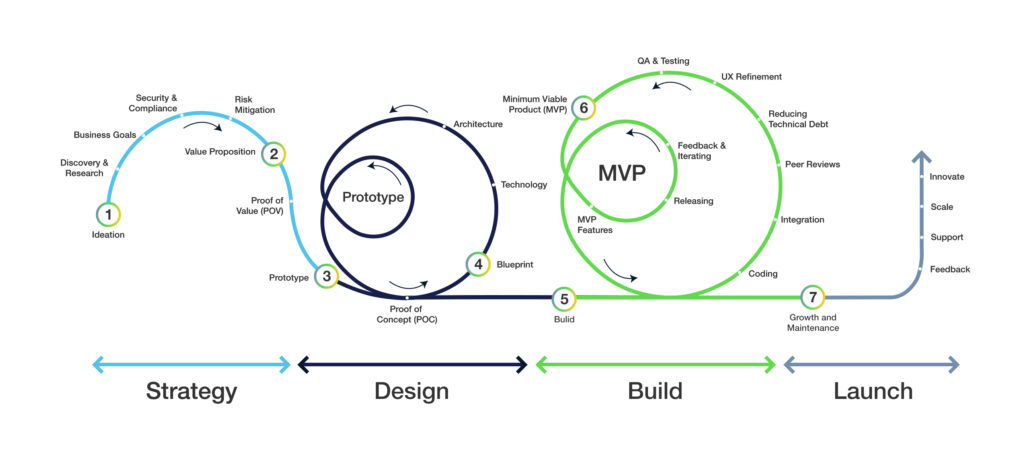The Software Product Development Life Cycle (PDLC) is a structured approach that guides software products from the Initial idea to their growth and maintenance. This seven-phase framework ensures that products are built with precision, market relevance, and scalability in mind. Each phase plays a crucial role in creating a product that not only meets user needs but also adapts to evolving demands. Let’s explore the seven key phases of the PDLC and understand how each contributes to a successful software product journey.

The first step in the Software Product Development Life Cycle (PDLC) is ideation—the process of brainstorming, researching, and validating product concepts. A strong foundation ensures the product solves a real problem, has a clear market fit, and stands out in a competitive market.
Skipping or rushing through this phase can lead to costly development mistakes, poor user adoption, or market failure. Investing time in thorough research and validation ensures a strong product roadmap before moving to the next stage—Prototyping (Proof of Concept).
A great product isn’t just about technology—it needs a clear value proposition to succeed in the market. This phase focuses on establishing Proof of Value (POV) and crafting a marketing and sales strategy that highlights how the software solves real-world problems.
A weak value proposition leads to poor adoption and market failure. This phase ensures the product is positioned effectively, creating a strong foundation for business growth before moving into full-scale development.
With a clear market strategy in place, the next step is to start building the product—where PDLC meets SDLC.
Once a software idea is validated, the next step is to develop a prototype or Proof of Concept (POC). This phase helps teams determine whether the product is technically feasible, cost-effective, and viable before full-scale development.
Skipping this phase can lead to unexpected technical challenges, high development costs, and delays. A well-executed POC ensures that the team moves forward with confidence and clarity into the next stage—Designing the Product Blueprint.
With a validated proof of concept (POC), the next critical step in the Software Product Development Life Cycle (PDLC) is designing the product. This phase focuses on translating ideas into a structured plan, ensuring seamless user experience (UX), system architecture, and technical specifications.
A well-structured product blueprint reduces development risks, enhances efficiency, and ensures that both developers and stakeholders have a clear roadmap. This phase directly influences product usability, security, and scalability—key factors in long-term success.
With the design finalized, it’s time to move on to defining the product’s value proposition to ensure market success.
Now that the product’s value proposition, design, and feasibility are validated, it’s time for full-scale development. This is where the Software Product Development Life Cycle (PDLC) intersects with the Software Development Life Cycle (SDLC), focusing on coding, testing, and iterative development.
Skipping structured development leads to security vulnerabilities, performance issues, and poor user experience. This phase ensures the product is built with scalability, security, and performance in mind before it reaches users.
With the product fully developed, the next critical step is launching the Minimum Viable Product (MVP) to test real-world adoption.
Before a full-scale launch, businesses release a Minimum Viable Product (MVP)—a streamlined version of the software with core functionalities. The goal is to gather real user feedback, validate assumptions, and refine the product based on market response.
Launching an MVP reduces financial risks and development inefficiencies by validating the product-market fit early. It helps businesses refine the software before a full-scale rollout, ensuring a higher success rate post-launch.
Once the MVP is refined, the next and final step is growth and maintenance—scaling the product while ensuring long-term success.
The final phase of the Software Product Development Life Cycle (PDLC) focuses on ensuring the product continues to grow, improve, and adapt to changing market conditions. This phase involves scaling the product, providing post-launch support, and continuously iterating to meet evolving customer needs.
This phase ensures that the product remains relevant and valuable to users over time. Focusing on continuous improvement, addressing customer needs, and maintaining robust post-launch support, helps businesses foster long-term success and position themselves as leaders in their respective markets. It’s not just about scaling the product—it’s about adapting to an ever-changing market and keeping the product innovative, secure, and aligned with user demands.
To recap, the seven phases of the Software Product Development Life Cycle (PDLC) – Ideation, Prototyping, Design, Defining the Value Proposition, Building the Product, MVP Launch, and Growth & Maintenance – provide a structured approach that ensures a software product is not only functional but also scalable, secure, and aligned with market needs. Each phase is crucial in minimizing risks, optimizing costs, and driving long-term product success.
A methodical PDLC allows businesses to carefully evaluate each stage, ensuring that the product meets user expectations, is market-ready, and can adapt to evolving demands.
Need help with your software development? Contact Charter Global today to leverage our expertise in delivering end-to-end software product development solutions. Let us guide you through each phase, ensuring your product’s success from ideation to growth!